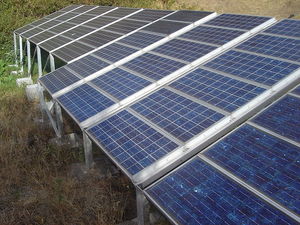Solar power is becoming an increasingly popular option for turning some roof or yard space into a means of partially or completely covering home electricity needs. Some intrepid do-it-yourselfers have turned to building their own solar electric panels, either for the challenge of it or to meet the custom specifications of a unique space or electrical demand that requires a custom-built solution. While building a homemade solar panel may not be as complicated as one might think, building one requires thorough planning and a combination of carpentry and wiring skills.
Calculating Demand
The first task is determining the demand to be met by the homemade solar electric panel or panels, and designing an entire system around that demand. Such panels rarely supply power directly to anything; instead, they are usually used to charge batteries, and the batteries then feed a steady supply of electricity to the home. In this example, the panel are meant to power a home office with a laptop, printer, a few lightbulbs, and a few other gizmos with a projected combined demand of 400 watts. That is how much power the batteries will need to supply every hour for, say, nine hours a day, for a total of 3,600 watts.
Most solar systems are designed so that total demand should be met by the panel during the average six hours of good daylight the system will receive during an average day. That means 3,600 divided by 6, so that the panel must be designed to generate 600 watts per hour.
Special Parts
The next step is to go shopping, and choose the type of solar cell you want to use. The individual solar cells will be assembled into a single panel. Other special electrical parts include a charge controller, at least one inverter (to convert the voltage), and one or more deep-cycle batteries (batteries designed to be drawn down and re-charged repeatedly). It would be a good idea to match the voltage of the solar cells to being just a point or two above the voltage of the battery, so only one inverter is needed. Otherwise, the voltage will need to be altered for the battery, and then again for the appliances in the system.
Sketch
Always start a complicated assembly job like this one by sketching the entire end product, including where the individual cells and their wires will go. A sketch helps to save time and avoid problems during the construction process.
Building the Box
A homemade solar panel is essentially a box for housing solar cells and protecting them from the elements. A typical method is to nail or screw sideboards around a plywood backing, and then to fasten a substrate of something like cork or pegboard into the interior. The entire thing is then primed and painted for protection from the weather, and then the individual solar cells are glued or screwed into place as planned. The wires from the cells are slowly bridged using wire nuts or wiring connectors, until all the cells feed through one wire. This tangled mess of wiring is best secured to the panel’s substrate using non-conductive silicon caulk. Ventilation holes and an exit hole for the single wire are then drilled. The wire is then threaded out of the panel. The whole thing is finished by fitting a piece of plexiglass to the top of the box, drilling holes, and screwing it on.
Completion
The finished panel should be erected in the direction where it will collect the most sunlight. The wires are fed into a charge controller, which will make sure that the current is steady and does not spike and fry the batteries. It will also control the current flow out of the battery, preventing the system from overdrawing power. The final, basic element is the inverter. This addresses two issues: that the solar electric panel and system up until now have been generating direct current (DC), and that the voltage is much lower than that used by almost all household appliances. An inverter will both format the current to alternating current (AC) and step the voltage up to something useful.
Sources: treehugger.com/files/2008/09/how-to-make-diy-cheap-inexpensive-solar-panels-ebay.php; virtualsecrets.com/build-a-solar-panel.html; mdpub.com/SolarPanel/index.html
